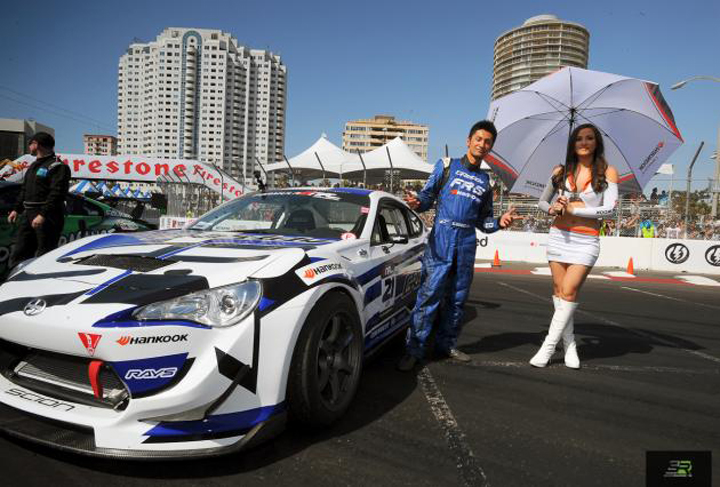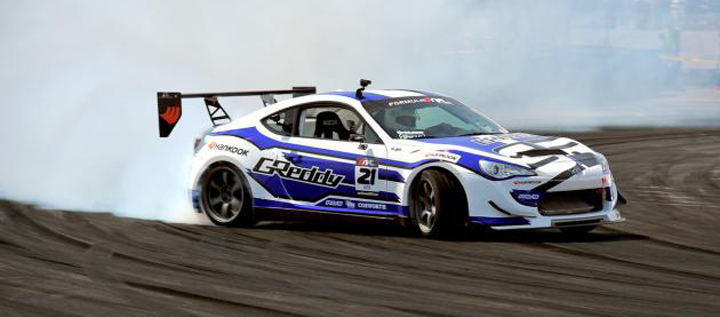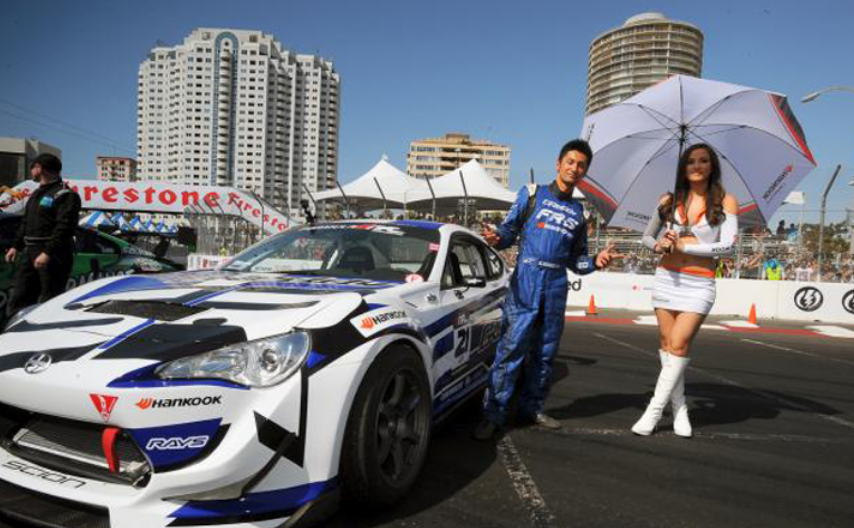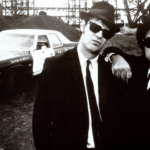
Ken Gushi is a well-known driver in the Formula Drift series. He started his racing career at age 15, before he had his driver’s license. He first made a name for himself in 2005 as the youngest driver in the D1 Grand Prix of Japan and Formula Drift in the U.S. Since then, he has worked up the ranks of the professional drift circuit. Ken has been with Scion for the last five years. For most of that time, he piloted a converted rear-wheel-drive Scion tC drift car. He now drives a race-prepped version of the Scion FR-S, the company’s new RWD sporty/performance car slated to go on sale in June 2012.
Future Collectible: 2013-15 Scion FR-S and Subaru BRZ
At the press launch event for the new Scion FR-S, we had a chance to sit down with Ken and discuss his rise to fame, his involvement with Scion, and his personal car.
Consumer Guide: So, Ken, how did you get into drifting?
Ken Gushi: Well, I was about 13 years of age, and at the time there was an anime series called Initial D, where they had an 18-year-old kid driving through canyons delivering tofu at 3 a.m. in a classic 1986 Toyota Corolla GT-S, which is a symbolic car for drifting. That’s what kicked it off for me, watching that anime series and being wowed by the kids drifting through the canyons and how cool it was that a low-horsepower, lightweight, rear-wheel-drive car can outrun cars such as the Nissan (Skyline) GT-R and whatnot. So, at that time, my dad coincidentally had a 1986 Toyota Corolla GT-S. I told him, “Hey, Dad, I just want to drive. I want to be like this kid, Initial D, and start drifting.”
He had this brilliant idea of taking me to a dry lake bed called El Mirage about an hour and a half north of Los Angeles. We took the car out there, and he put me in the driver’s seat and told me to do whatever I could. I got up to the dry lake bed and started doing donuts. I didn’t really know what I was doing, just getting on the gas and making the car rotate. I don’t know how many donuts I’ve done in my life, but we used to go there almost on a weekly basis, and then there was one point where one of my dad’s friends told him to get into the car and see what he could do. It turns out that a couple of months later, I became a better so-called “drifter” than my dad. I picked it up very quickly. He told me, “Hey, you should really consider doing motorsports.” Since we started on the dirt, he thought it would be cool if I stepped into rally. That was his initial motive, was to get me into rally racing and see where that would take us. At the same time, drifting as a sport had made its way over to the United States from Japan, and my dad found out that there was this great opportunity happening, really relatively close to where I lived, at Irwindale Speedway. So he was like, “Let’s just give it a try—you might like it, you might not.”
So we took his Toyota Corolla and entered an event and found out that we did really well. I was 14 years of age at the time. But we did really well considering that it was our very first event against other drivers in a form of competition. At that moment, he saw that we had great potential in my driving abilities. We invested in another car, a 1992 Nissan 240SX. So with that car, besides learning how to drive, I learned all my mechanical skills. I did my first engine swap at the age of 15. Just really learned everything I know about cars today with that car with the assistance of my father.
Drifting at different events here and there, about two years go by, and I’m almost 16 years old when I get sponsored for the first time. This was before the first major competition happened, where drivers are invited to Japan, the motherland of drifting. So there’s going to be all these professional drivers, and I’m invited by the organization to be a part of the series, and so I’m sponsored, I’m considered a pro, and that’s where my professional career kicked off, with that event in 2005. That was the D1 Grand Prix of Japan. Ever since that event, drifting as a sport has evolved in the States. We have our own drifting series now called Formula Drift, which is a big event. It’s gone international now to places like Abu Dhabi and Southeast Asia—like Singapore, China, Indonesia, Malaysia—and we have events in South America. It’s gone pretty global now, and I’ve been a part of the drift series ever since the beginning.
Consumer Guide: So now you’re with Scion, and you’re campaigning the new FR-S in the Formula Drift Series this year. Obviously that’s a race-prepared car, but as I understand it, you’ve had a lot of seat time already in some stock, street-legal FR-S models, too. Can you tell us a little about your involvement with bringing the FR-S to market?
Ken Gushi: So I’ve been with Scion Racing for five years now, and we started off with a rear-wheel drive converted Scion tC. They come out as a front-wheel drive, and there was no way in hell that they were going to drift a front-wheel drive car. So obviously you have to make heavy modifications to make it competitive in drifting. With that car, we learned a lot about the dynamics of driving, and even about the tC in general. When we first started off with that car, we got a lot of criticism from other car manufacturers saying, “That’s not a true rear-wheel drive, that shouldn’t be able to compete in the Formula Drift series.” But that car had so much of an impact in the sport of drifting that it brought a lot of new people into the sport of drifting that had never seen drifting before, that were just Scion fans. So now we have a way of engaging Scion owners in the sport of drifting, whether they own a rear-wheel-drive car or not. Just because they own a Scion, it gives them a way to connect to the sport of drifting.
There was so much talk about bringing a rear-wheel-drive Scion to the family, and that’s kind of where the FR-S comes in. I’ve been hearing about the FR-S before it was even called the FR-S. It was called the 086A or the GT86 or the ST86, and there were so many different variations of what we call the FR-S. But before the FR-S, we had been talking about it for a few years, like, “How would we bring this car into the Scion family? Is it going to be good for drifting?” In fact, some of the engineers came to take a look at our Scion tC just to see how we were running the car in the drift series. So today we have the FR-S. I have driven a lot of it in stock form. It’s, first of all, a car that anyone can enjoy, whether you’re a Sunday club racer or just someone that doesn’t have track experience but wants to have an enjoyable car for everyday use. The moment you sit in it, before you even start the car, you feel like it’s a class of its own. That’s the first impression that I got from the car, although I could say that when I first sat in it and drove it for the first time, it could use maybe another 50 horsepower or more.
Consumer Guide: But what vehicle couldn’t use more power?
Ken Gushi: Yeah! But I soon started to realize that the more I pushed it, and the more I started to learn about the car, it wasn’t really about the numbers, it was just how much you can actually enjoy the drive, how far can you push the car to its limits, and the limits are pretty far. It’s going to take the average person a lot to get it to the limit. So yeah, today we use it in professional drifting. Actually, a company called Greddy Performance Products in Irvine, California, they’re the ones that sponsor me and built the car from the ground up. Having driven the stock form and now that I have something to compare it with, the competition car that we use today is extremely, well, considering we only had a couple hours of testing time, we finished pretty strong in our very first event at Long Beach. We’re very excited about the car.
Consumer Guide: I also understand that you are the driver in some upcoming advertising spots.
Ken Gushi: Yeah. Scion actually gave me the perfect opportunity to be a part of the commercial shoots. It makes sense. I’m like their poster-child for drifting. They wanted to have some drifting scenes in the commercial, so I thought it was a great idea to have me out there doing some drifting shots in the car. I think it’s a first for Scion to have this commercial that’s very action-, sports-oriented with a lot of driving in it, where previous commercials were more about the lifestyle. This is real, raw footage that you will see in the commercials, and I was honored to be a part of it.
Consumer Guide: So when you’re not driving the FR-S, what do you drive?
Ken Gushi: I have a 1986 Toyota Corolla GT-S, the hachi-roku [the numbers 8-6 in Japanese] is what they call it. It is the car that started everything for me, so it makes sense that I still have one 12 years after I started drifting. However, my Corolla is not any ordinary Corolla. It’s turbocharged, 2.0-liter. I don’t want to say this, but it’s got a Nissan engine in it, an SR20. The reason I did that was because I take this car to drifting events to practice, keep myself conditioned against other drivers, and when other drivers bring in 240SXs with V8 engines, it’s a beater car for them, but it’s tough keeping up with those V8s with a 4A-GE 16-valve 1.6-liter 4-cylinder. That was my whole reason behind the SR swap. But the dynamics of the way the car feels stays true to what a hachi-roku is. It’s very lightweight, agile, very responsive, and it’s a lot of fun to drive.
Consumer Guide: How often do you get out to the track to practice?
Ken Gushi: I usually try to go out at least once a week. There’s a place in Riverside, California, called Adam’s Motorsports Park, where they allow us to take our drift cars on a go-kart track. They allow drifting every Thursday night. It’s pretty cheap for what it is, 20 bucks an hour. And anyone can do it. You can practice tandem, you can practice your solo run. It’s just a great way to provide the public a place to drift. Because obviously you can’t be doing it on a public street; it’s very dangerous and it doesn’t make sense to endanger other people. So, it’s a great thing that Adams Motorsports Park provides it. I think a lot more racetracks should be open to the idea of having public drift sessions for a little fun.
Consumer Guide: Do you have any advice for those looking to break into the drifting circuit?
Ken Gushi: Yeah, I feel like drifting is still relatively easy to get into. Not necessarily the pro scene, but the sport of drifting could be relatively cheap if you do it smart. Just buy used tires, a cheap rear-wheel-drive car, and either weld your differential or get a limited-slip differential of some sort. Go out to these drifting events and have fun. The best way to learn quick is to have fun and enjoy it. I’ve seen guys that pressure themselves, and they try so hard, but they never get it down. It’s the other guys who are out there having fun that just improve like crazy. So go out there with a cheap rear-wheel-drive, buy cheap tires, and have fun.


Scion’s Dead. Here’s Which Models Live on as Toyotas (Full Brand Gallery)



